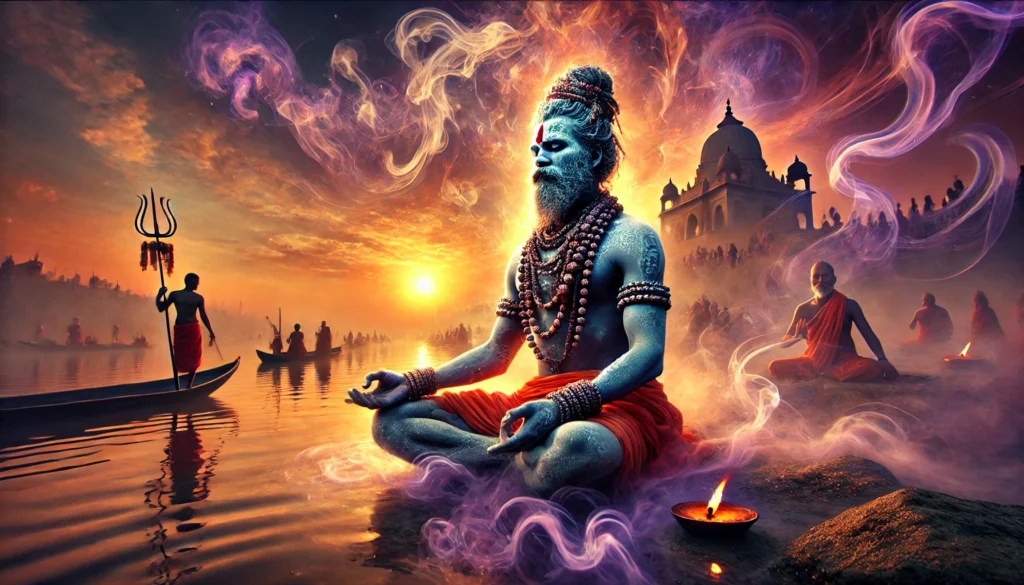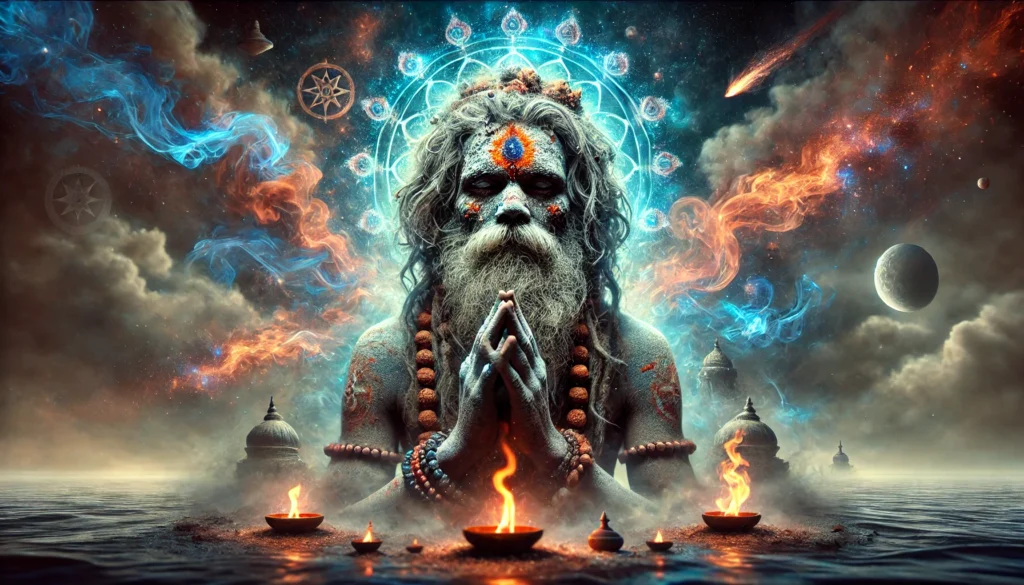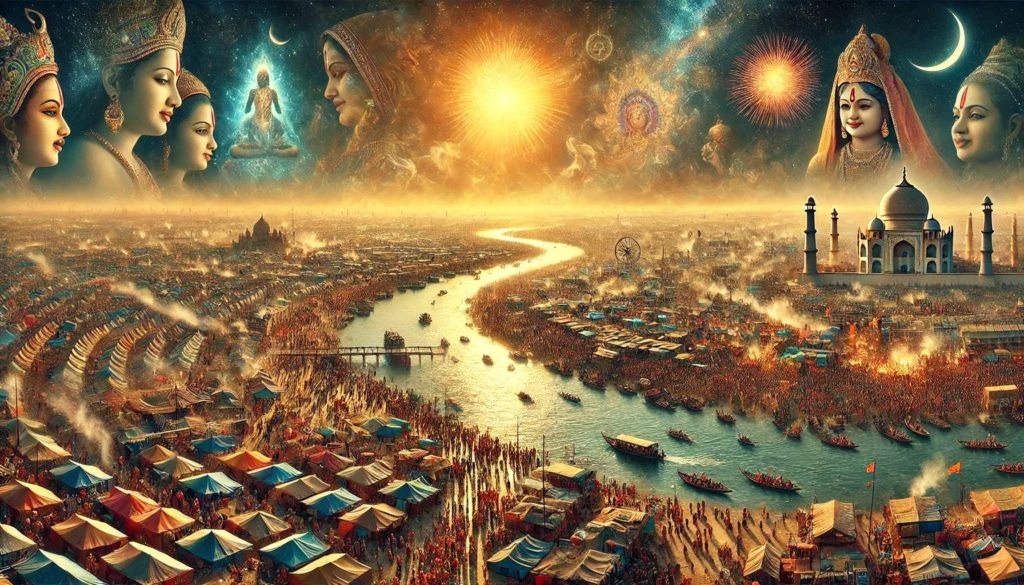Introduction
Imagine the sight of millions of devotees gathered along the banks of sacred rivers, performing ancient rituals under the celestial sky. This is Kumbh Mela, the world’s largest spiritual gathering, where faith meets cosmic alignment and Vedic wisdom. Recognized by UNESCO as an intangible cultural heritage, Kumbh Mela transcends religious boundaries, inviting global audiences to explore its mysteries.
Kumbh Mela is not just a festival but a profound spiritual experience rooted in ancient scriptures and celestial alignments. As we approach Kumbh Mela 2025, this article will delve into its mythological origins, astronomical significance, and spiritual essence while uncovering its cosmic connection with the universe.

The Mythological Origins: Samudra Manthan
The origins of Kumbh Mela lie in one of Hinduism’s most iconic tales – the Samudra Manthan (Churning of the Ocean). This story, chronicled in the Vishnu Purana and Bhagavata Purana, unfolds as a cosmic tug-of-war between the Devas (gods) and Asuras (demons). The goal? To obtain Amrit (nectar of immortality) hidden within the ocean’s depths.
The churning began with Mount Mandara as the churning rod and the serpent Vasuki as the rope. As the gods and demons pulled, various divine objects emerged from the ocean, including the moon, celestial animals, and ultimately, the pot of nectar. To protect it from the demons, Lord Vishnu assumed the form of Mohini, a divine enchantress, and distributed the nectar among the gods. In the chaos, a few drops of Amrit spilled on Earth at four locations: Haridwar, Prayagraj (Allahabad), Nashik, and Ujjain.
These locations became sacred sites where the nectar’s divine energy infused the rivers, creating the foundation for Kumbh Mela.
Sanskrit Shloka: “अमृतां धारण्य जीवन्तु कारण्यमुद्धिस्थिति । मोहिन्या स्वरूपो द्रव्यं नास्तिकृत्यमुप्पर्णम्।”
Translation: “The divine nectar, the essence of immortality, was churned from the ocean by the gods and demons, guided by Mohini, the divine enchantress.”
Each drop of nectar at these locations became a point of spiritual power, forming the basis of the Kumbh Mela tradition.
Kumbh Mela : Astronomical and Astrological Significance
The grandeur of Kumbh Mela is intricately linked to the cosmos. The dates of the Mela are determined by the unique alignment of celestial bodies. Kumbh Mela 2025, for instance, aligns with the transit of Jupiter (Guru) into Aquarius (Kumbha) and the positioning of the Sun and Moon in Capricorn.
Jyotish Shastra, the ancient science of Vedic astrology, plays a pivotal role in these calculations. During specific planetary alignments, the sacred rivers are believed to become charged with divine energy, amplifying their spiritual potency.

Key Astronomical Facts:
- Jupiter, known as the planet of wisdom and spirituality, represents divine energy and expansion. Its presence in Aquarius signifies a period of heightened consciousness.
- The Sun and Moon’s alignment with Jupiter during Kumbh enhances the cosmic vibrations, creating a unique spiritual atmosphere.
- These alignments occur only once every 12 years, making each Kumbh Mela a rare and auspicious event.
Sanskrit Insight: “गुरौह कालस्य विधिच्छति सिन्धु। ज्योतिषम् योगम् चैत्यं प्रज्ञा।”Translation: “The alignment of planets enhances the sacred waters, bestowing blessings and enlightenment to the devoted.”
Vedic Concepts of Time and Space
The Kumbh Mela embodies the Vedic understanding of time (Kala) and space (Desha). In Vedic cosmology, time is cyclical, moving through four Yugas: Satya, Treta, Dvapara, and Kali. These cycles reflect the rise and fall of dharma (righteousness).
Kumbh Mela’s periodicity resonates with this cyclical nature. The 12-year cycle of the festival corresponds to the journey of Jupiter through the zodiac, symbolizing renewal and spiritual rejuvenation.
Tirtha Sthalas (Sacred Spaces): The four Kumbh locations are considered energy vortexes, where the divine and earthly realms intersect. Bathing in these waters during Kumbh is believed to cleanse sins and align individuals with cosmic rhythms.
The rivers themselves are central to Vedic cosmology. The Ganga, Yamuna, and Saraswati rivers at Prayagraj symbolize the physical, mental, and spiritual purification necessary for liberation.
Sanskrit Shloka: “कालास्य चक्रे च गती पापुनी स्मृतो। तीर्थ्यां पावना नास्तिकारणोपान्न्।”Translation: “In the sacred waters and at the confluence of rivers, one attains spiritual liberation and purification of sins.”

Spiritual Relevance of Kumbh Mela
At its core, Kumbh Mela is a celebration of Moksha (liberation). The Shahi Snan (royal bath), where saints and sadhus lead the ceremonial dip, symbolizes the washing away of sins and the rebirth of the soul.
Key Rituals:
- Shahi Snan: The royal procession and collective bathing led by Akharas (monastic orders).
- Yajnas and Homas: Fire rituals invoking cosmic energies.
- Spiritual Discourses: Teachings from saints and spiritual leaders.
These rituals are rooted in the Vedic philosophy that emphasizes the purification of the soul and alignment with divine forces. Participating in the Kumbh’s sacred practices is believed to break the cycle of birth and death.
Kumbh Mela as a Global Phenomenon
Kumbh Mela’s grandeur has earned it global recognition. In 2017, UNESCO declared it an intangible cultural heritage, acknowledging its universal appeal and cultural significance.
Global Impact:
- Scholars, spiritual seekers, and tourists from around the world flock to witness this extraordinary gathering.
- Kumbh Mela has inspired studies in sociology, spirituality, and even crowd management, showcasing the harmonious coexistence of millions.
- Documentaries and books have brought the festival to international audiences, making it a symbol of India’s spiritual heritage.

FAQs
What is the significance of Kumbh Mela in Hinduism?
Kumbh Mela represents a confluence of devotion, cosmic alignment, and spiritual cleansing. It is a journey toward Moksha.
How is Kumbh Mela connected to Samudra Manthan?
The tradition stems from the mythological story of drops of nectar falling on Earth during the celestial battle for Amrit.
What are the spiritual benefits of attending Kumbh Mela 2025?
Participants believe in gaining spiritual merit, cleansing of sins, and connecting with divine energies.
Why are specific locations chosen for Kumbh Mela?
The four locations – Haridwar, Prayagraj, Nashik, and Ujjain – correspond to the places where drops of nectar fell, making them sacred.
Conclusion
Kumbh Mela is more than a festival; it is a timeless journey into the heart of Vedic wisdom and spiritual awakening. Rooted in mythology, guided by celestial forces, and celebrated with unwavering devotion, it remains a testament to humanity’s quest for the divine.
As we approach Kumbh Mela 2025, let us embrace its profound mysteries and cosmic significance. Whether as a pilgrim or a seeker, the Mela invites all to bathe in its eternal wisdom. Are you ready to embark on this sacred journey?
